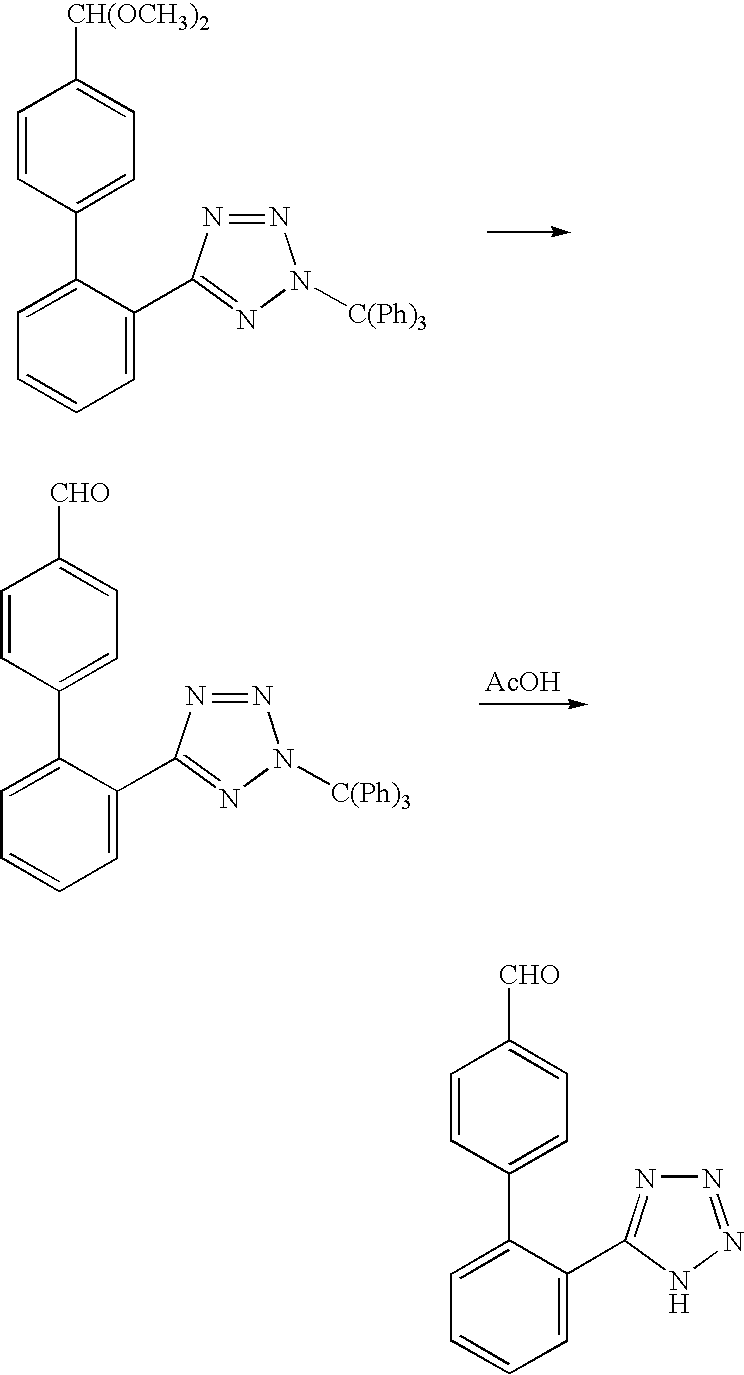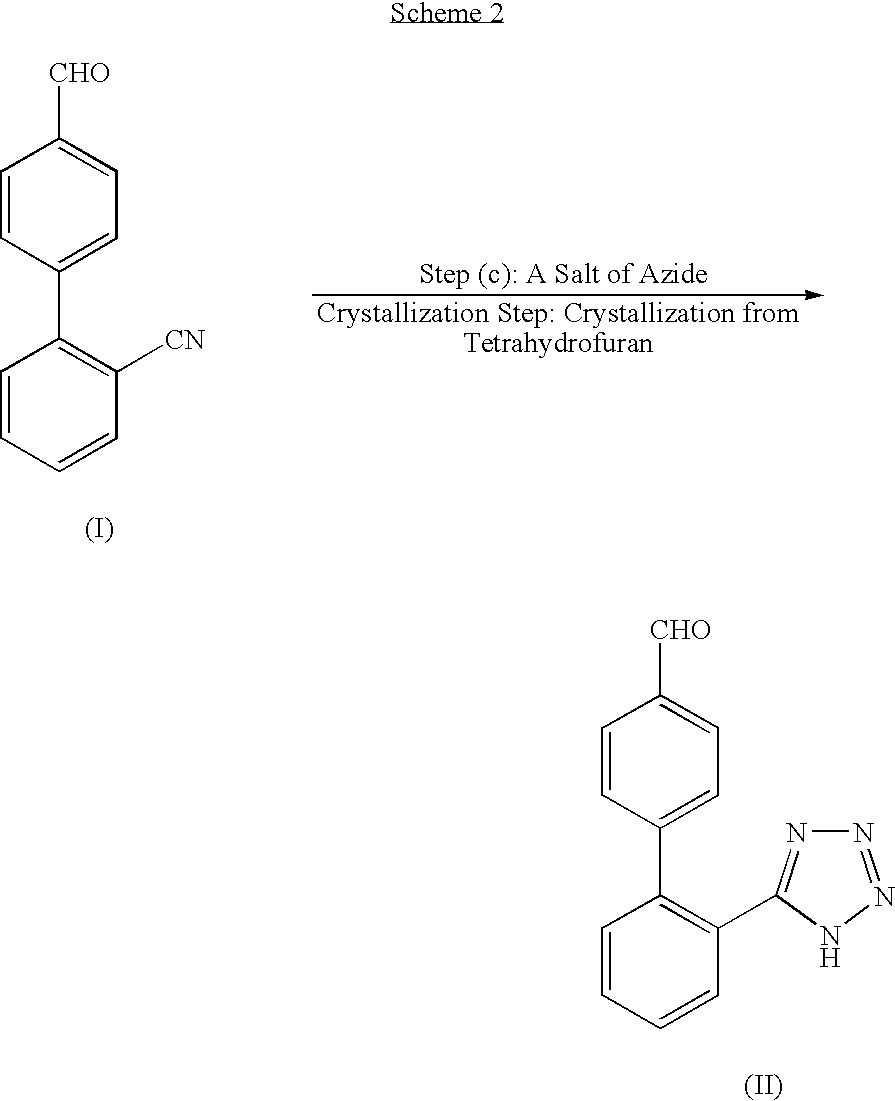Process for producing 2'-(1h-tetrazol-5-yl)biphenyl-4-carbaldehyde
a technology of biphenyl-4-carbaldehyde and process, which is applied in the direction of biocide, heterocyclic compound active ingredients, organic chemistry, etc., can solve the problems of insufficient yield, difficult to obtain, and insufficient above-mentioned method as an industrial production method, etc., and achieve high yield
- Summary
- Abstract
- Description
- Claims
- Application Information
AI Technical Summary
Benefits of technology
Problems solved by technology
Method used
Image
Examples
example 1
Production of CBAL
[0109] To monochlorobenzene (1000 g) was added CMBMB (400 g, 1.47 mol), then, water (812 g), hexamethylenetetramine (412 g, 2.94 mol) and acetic acid (618 g, 10.29 mol) were added, then, the solution was stirred at 93° C. for 9 hours. The solution was allowed to stand still for 1 hour at 85 to 90° C. and phase-separation was conducted. To organic layer was added water (795 g), then, 10% potassium carbonate aqueous solution (684 g) was added to control pH at from 7 to 8. The solution was allowed to stand still for 1 hour, then, phase-separation was conducted. 142 ml of monochlorobenzene was distilled off at 85 to 95° C. under a reduced pressure of 22.7 to 33.3 kPa. The solution was stirred at 70° C. for 2 hours to cause growth of crystals, then, cooled down to 0 to 5° C. at a rate of 10° C. / hour and stirred at the same temperature for 5 hours. Filtration is performed, and the resultant crystals were washed with monochlorobenzene (400 g) cooled to about 5° C. and dr...
example 2
Production of CBAL
[0112] (1) To monochlorobenzene (450 g) was added CMB (300 g, 1.55 mol), and solution prepared by dissolving sodium bromate (50.1 g, 0.33 mol) in 95.3 g of water was added. 2,2′-azobis(2-methylbutyronitrile) (2.0 g, 0.01 mol) was dissolved in monochlorobenzene (10 g), and this solution was added to the above-mentioned solution at 75° to 85° C., then, immediately, solution prepared by dissolving 2,2′-azobis(2-methylbutyronitrile) (89 g, 0.05 mol) in monochlorobenzene (48.8 g), and bromine (198.5 g, 1.24 mol) were dropped simultaneously respectively at 70 to 80° C. The solution of 2,2′-azobis(2-methylbutyronitrile) was dropped at a rate of about 0.22 g / min and bromine was dropped at a rate of about 0.73 g / min. The added solution was stirred for 5 hours at 70 to 75° C., and the reaction solution was checked under HPLC analysis conditions (1), and that the area percentage of raw materials reached 1% or less was confirmed, obtaining a mixed solution of CMBMB and CDBMB....
example 3
Production of TBAL Crude Crystals
[0116] To monochlorobenzene (8510 g) was added CBAL (1294 g, 6.24 mol) triethylamine hydrochloride (2579 g, 18.73 mol), and under a nitrogen atmosphere, sodium azide (1218 g, 18.73 mol) was added and the mixture was heated at about 110° C. and stirred. Under HPLC analysis conditions (2), the reaction solution was checked, and when the area percentage of a raw material CBAL reached 1.0% or less, the solution was cooled to about 10° C. Tetrahydrofuran (12.64 kg) and water (4.79 kg) were added, then, 15% sodium nitrite aqueous solution (5.745 kg, 12.49 mol) was added. pH was controlled at 5.0±0.1 by dropwise addition of 17.5% hydrochloric acid (7.03 kg).
[0117] The solution was allowed to stand still, then, aqueous layer was separated and remove, and organic layer was concentrated at 35 to 45° C. under a reduced pressure of 40 to 45 kPa. When the amount of the distilled liquid reached 12.2 kg (about 10% w / w, as amount of remaining liquid), concentratio...
PUM
 Login to View More
Login to View More Abstract
Description
Claims
Application Information
 Login to View More
Login to View More - R&D
- Intellectual Property
- Life Sciences
- Materials
- Tech Scout
- Unparalleled Data Quality
- Higher Quality Content
- 60% Fewer Hallucinations
Browse by: Latest US Patents, China's latest patents, Technical Efficacy Thesaurus, Application Domain, Technology Topic, Popular Technical Reports.
© 2025 PatSnap. All rights reserved.Legal|Privacy policy|Modern Slavery Act Transparency Statement|Sitemap|About US| Contact US: help@patsnap.com



